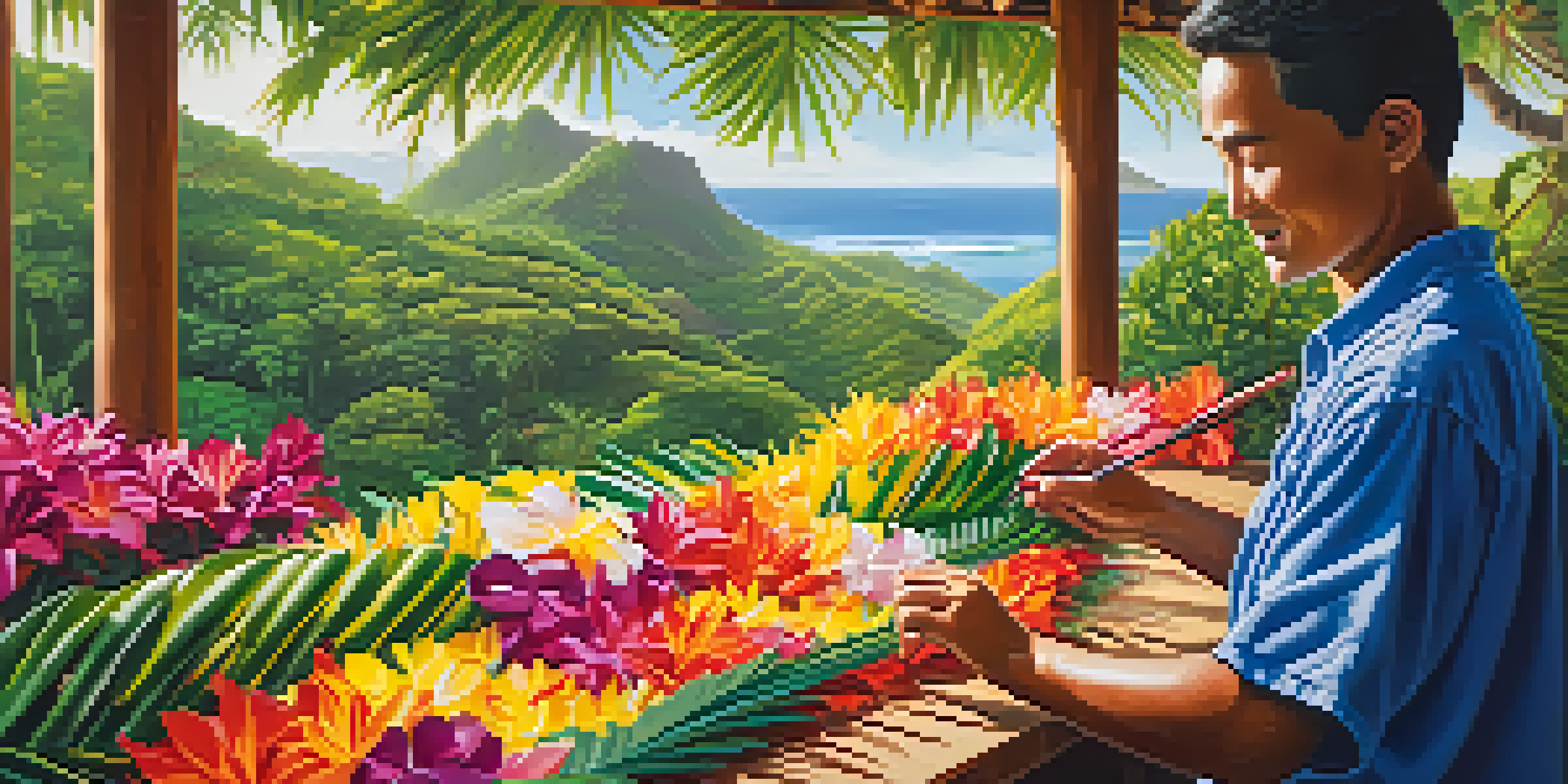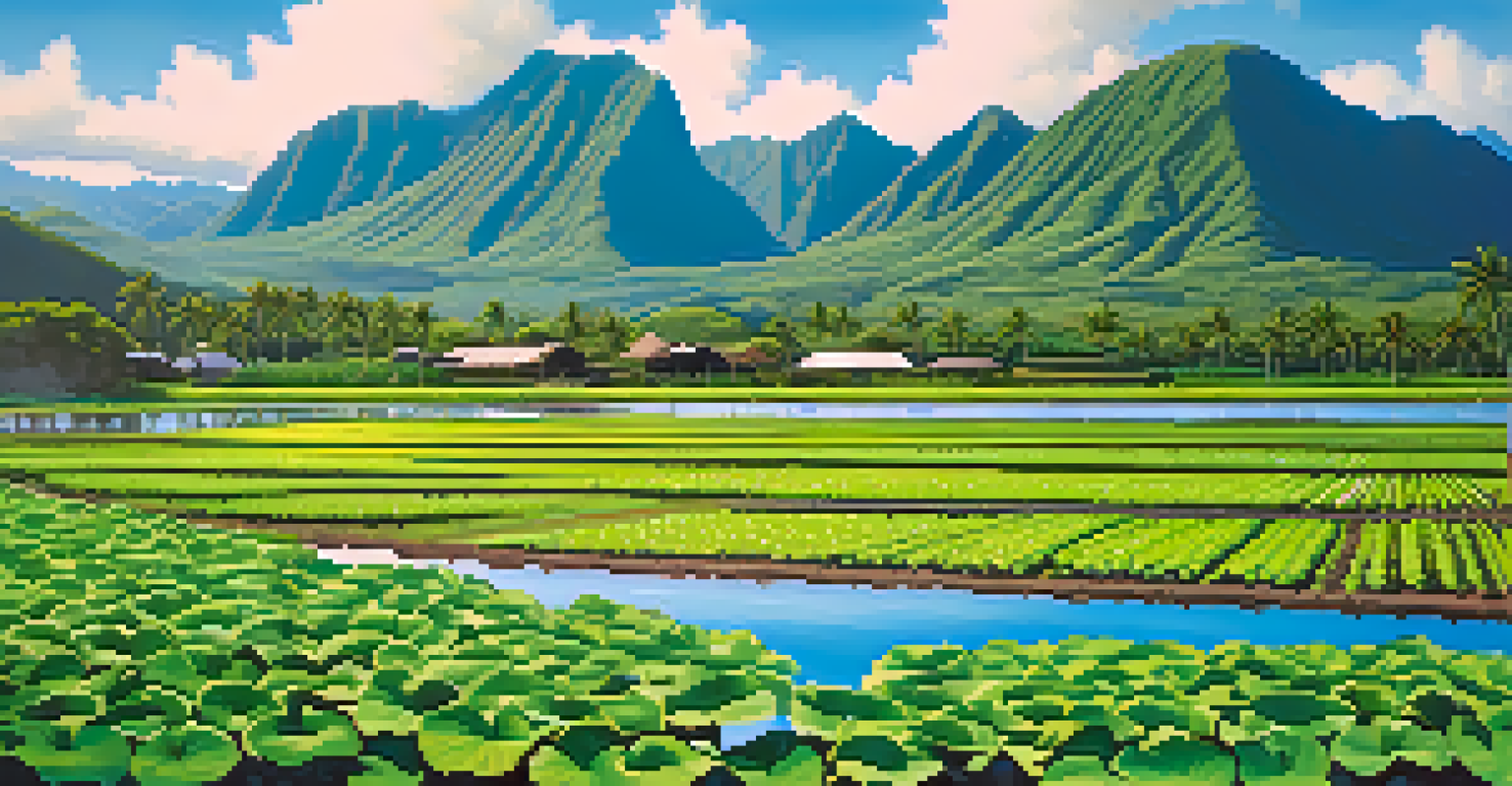Traditional Hawaiian Practices and Their Impact on Heritage

Understanding Traditional Hawaiian Practices and Culture
Traditional Hawaiian practices are deeply rooted in the islands' rich history and cultural identity. These practices encompass a wide range of activities, including hula, lua (martial arts), and the art of lei-making. Each of these customs not only serves as a form of expression but also as a means of preserving the stories and beliefs of the Hawaiian people.
The land is our greatest teacher. It is the source of our sustenance, our spirituality, and our identity.
At the heart of these practices is a profound connection to the land, or 'aina,' which plays a vital role in Hawaiian spirituality and daily life. The reverence for nature is evident in traditional agricultural methods, like the cultivation of taro, which holds both nutritional and cultural significance. This intertwined relationship between the people and their environment is a cornerstone of Hawaiian heritage.
By engaging in these practices, both locals and visitors can gain a deeper appreciation for the values and stories that shape Hawaiian culture. Whether through participating in a hula class or visiting a taro farm, individuals can experience firsthand the importance of these traditions in maintaining the identity of the Hawaiian people.
The Role of Hula in Hawaiian Cultural Identity
Hula is more than just a dance; it is a vital expression of Hawaiian culture and history. Each movement and chant tells a story, often reflecting the beauty of nature, mythology, or historical events. This dance form serves as a living history that connects generations, making it an essential aspect of Hawaiian identity.

Traditionally, hula was performed in sacred places, often as part of religious ceremonies. It was a way to honor the gods and preserve oral histories, ensuring that the knowledge would be passed down through the ages. Today, hula continues to be celebrated during festivals and cultural events, allowing both locals and tourists to engage with this vibrant aspect of Hawaiian heritage.
Hula: A Living Expression of Culture
Hula serves as a vital connection to Hawaiian history, conveying stories and values through movement and chant.
As hula schools proliferate and competitions showcase talent, the importance of preserving this art form becomes clear. By fostering a community of hula practitioners, Hawaii not only honors its past but also inspires future generations to embrace and continue these cherished traditions.
The Spirituality of Traditional Hawaiian Practices
Spirituality is intricately woven into the fabric of traditional Hawaiian practices. Many customs are rooted in the belief that everything is interconnected, and this worldview shapes how Hawaiians engage with their environment and each other. Spiritual practices often involve rituals that honor ancestors, nature, and deities.
In Hawaii, the language and culture are intertwined; to understand one is to understand the other.
One prominent example is the practice of offering 'oli, or chants, which serve as a way to connect with the spiritual realm. These chants can be used in various contexts, from ceremonies to personal reflections, emphasizing the importance of expressing gratitude and respect. Understanding these spiritual dimensions can deepen one’s appreciation for Hawaiian culture.
As modern influences encroach upon the islands, the preservation of these spiritual practices becomes increasingly vital. By keeping these traditions alive, Hawaiians not only safeguard their cultural heritage but also promote a sense of identity and belonging within their communities.
Sustainable Practices in Traditional Hawaiian Agriculture
Traditional Hawaiian agriculture is a prime example of sustainable practices that respect the land and its resources. Techniques such as 'lo'i' (wetland taro farming) and 'kalo' (taro) cultivation demonstrate a profound understanding of the ecosystem. These methods allow Hawaiians to thrive while maintaining a balance with nature.
The ancient practice of aquaculture, especially the cultivation of fish in fishponds, showcases the ingenuity of traditional farming methods. These ponds not only provided food but also created habitats for various marine life, reinforcing the idea of living in harmony with the environment. Such sustainable practices are critical in today’s context of environmental challenges.
Sustainable Agriculture Practices
Traditional Hawaiian agriculture exemplifies sustainability by harmonizing with the land and preserving resources for future generations.
By reviving these traditional agricultural techniques, Hawaiians can reclaim their heritage while promoting sustainability. This approach not only nurtures the land but also strengthens community ties and fosters a deeper understanding of the importance of preserving natural resources for future generations.
The Art of Lei-Making and Its Cultural Significance
Lei-making is a cherished Hawaiian tradition that embodies love, respect, and connection. A lei, typically made from flowers, leaves, or shells, is often given as a symbol of affection or appreciation during special occasions. This beautiful art form reflects the spirit of aloha, which emphasizes compassion and kindness.
The process of creating a lei involves careful selection of materials and an understanding of the seasonal availability of plants. Each flower or leaf carries its own meaning, adding layers of significance to the lei. This practice not only connects individuals to their culture but also highlights the importance of the natural world in Hawaiian life.
As tourists often seek out lei-making experiences, this tradition serves as a bridge between cultures. By participating in this craft, individuals gain insight into Hawaiian values and the deep connections that bind the community together, fostering a greater appreciation for the islands' rich heritage.
Preserving Hawaiian Language Through Cultural Practices
The Hawaiian language, or 'Ōlelo Hawai'i, is a crucial component of the islands' cultural identity. Traditional practices play a significant role in preserving and revitalizing this language, as many customs are expressed through songs, chants, and storytelling. Engaging in these activities provides a natural context for learning and using the language.
Classes and workshops that emphasize traditional practices often incorporate 'Ōlelo Hawai'i, allowing participants to connect with the language in a meaningful way. This immersion not only helps to keep the language alive but also reinforces a sense of pride in Hawaiian heritage. Language and culture are inseparable, and the revival of one supports the other.
Community Efforts Reviving Heritage
Local initiatives and festivals are crucial in educating younger generations about traditional practices, ensuring the continuity of Hawaiian culture.
As more individuals embrace the Hawaiian language, the efforts to preserve it grow stronger. This resurgence is vital for maintaining cultural identity, ensuring that future generations can experience and appreciate the richness of their heritage through language.
Community Efforts to Revive Traditional Practices
Community initiatives have become instrumental in reviving traditional Hawaiian practices. Local organizations and cultural groups are dedicated to teaching younger generations about their heritage, ensuring that these practices do not fade into obscurity. Workshops, festivals, and cultural events play a pivotal role in this revival.
One notable example is the annual Merrie Monarch Festival, which celebrates hula and Hawaiian culture. This event not only showcases talent but also fosters a sense of pride and belonging among participants and attendees alike. Such gatherings connect people to their roots and promote the continuation of traditional practices.

By prioritizing education and community engagement, these efforts help to instill a sense of responsibility in the younger generation. As they learn about their heritage, they become advocates for preserving these practices, ensuring that the essence of Hawaiian culture remains vibrant and alive.